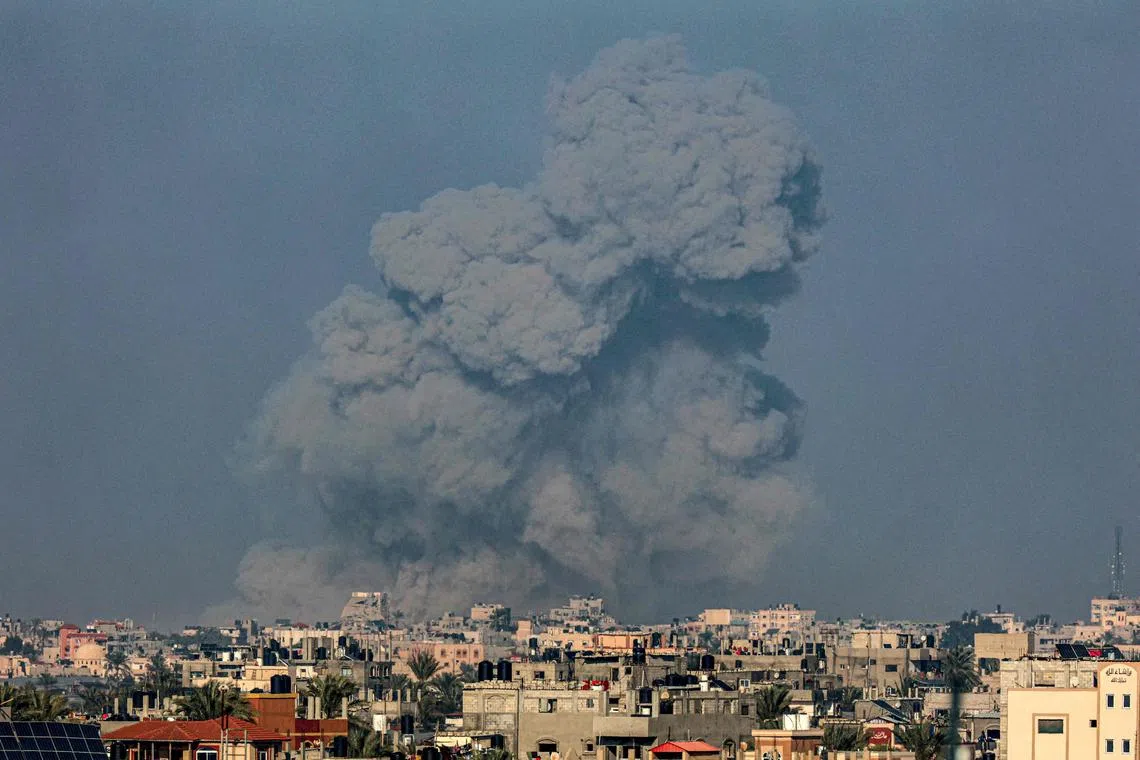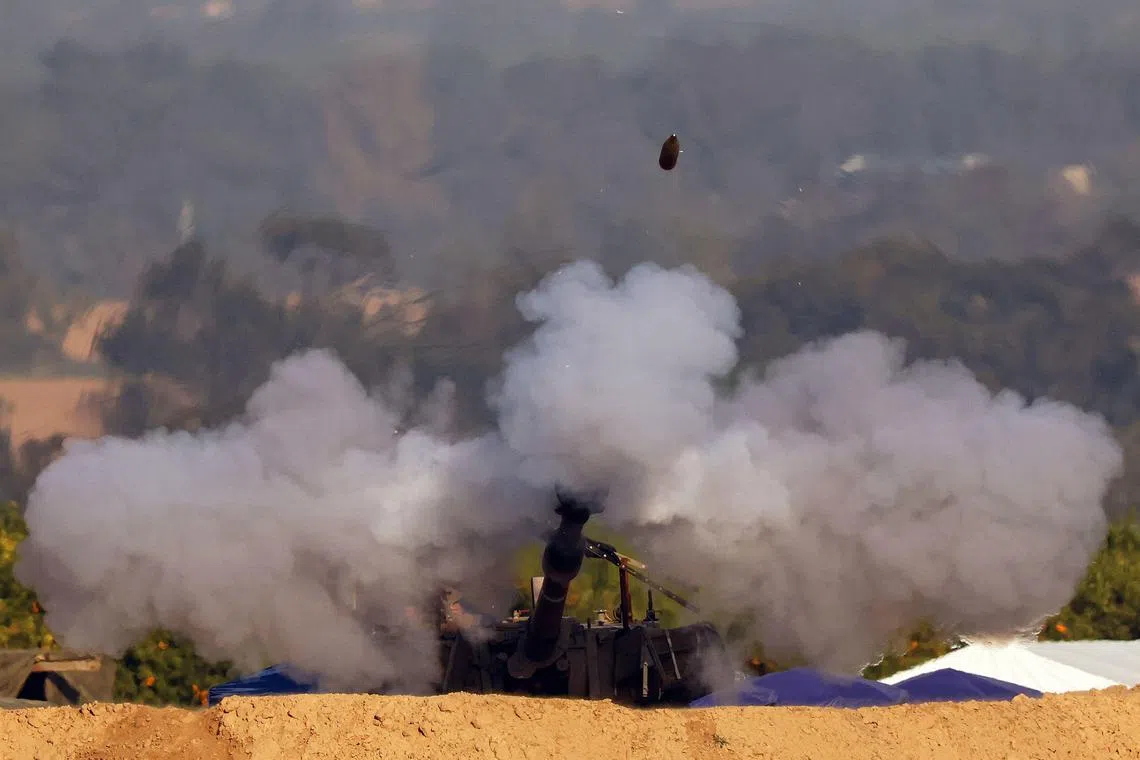Gunfire, air strikes as Israel pushes south against Gaza militants
Sign up now: Get ST's newsletters delivered to your inbox

Smoke billowing over Khan Younis in the southern Gaza Strip, during Israeli bombardment on Jan 19.
PHOTO: AFP
Follow topic:
GAZA STRIP, Palestinian Territories – Gunfire and air strikes on Jan 19 shook Gaza’s city of Khan Younis, where Israel is pressing its southward push against Hamas militants.
The Palestine Red Crescent Society reported intense artillery fire near the city’s Al-Amal hospital, while the Health Ministry in Hamas-run Gaza said 77 people were killed and dozens wounded overnight.
At the city’s Al-Nasser hospital, a child with a bloodied face cried on a gurney. Ambulances arrived with the injured and the dead while in the darkened city beyond, automatic weapons fire sounded.
An orange fireball flashed above rooftops and an AFP journalist saw plumes of dark smoke towering above the city in nearby Rafah, the Gaza Strip’s southernmost city.
Israel says it still expects the war, which began with unprecedented Hamas attacks on Oct 7,
The United Nations says it has displaced roughly 85 per cent of Gaza’s people and warns that improved aid access is needed urgently as famine and disease loom.
The UN Children’s Fund, or Unicef, said nearly 20,000 babies in Gaza have been born “into hell”
A communications blackout, which Internet monitor NetBlocks said has stretched into its eighth day, the longest outage during the war, only worsens the challenges.
Mr Metawei Nabil, recently released by Israeli forces and bearing scars on his arms, told AFP he fled Beit Lahia in northern Gaza only “to face death” in devastated Rafah near the Egyptian border.
Among the rubble
The Oct 7 attacks resulted in the deaths of about 1,140 people in Israel, most of them civilians, according to an AFP tally based on official Israeli figures.
Militants also seized about 250 hostages, around 132 of whom Israel says remain in Gaza. At least 27 hostages are believed to have been killed, according to an AFP tally based on Israeli figures.
Israel has vowed to destroy Hamas in response. Its relentless air and ground offensive has killed at least 24,762 Palestinians, around 70 per cent of them women, young children and adolescents, according to Gaza’s Health Ministry.

An Israeli howitzer firing a shell from southern Israel towards the Gaza Strip.
PHOTO: AFP
With Israel’s military offensive moving farther south in the territory, which is about 40km long, some residents in northern Gaza have begun returning home to what remains of their neighbourhoods.
In Rimal district, rubble has been ploughed to the sides of some dirt roads, but others are still clogged with pieces of collapsed buildings.
“Everything is destroyed and the people are dying of hunger,” said Mr Ibrahim Saada, who said he lost his whole family.
Israel’s army in early January said the Hamas command structure in northern Gaza had been dismantled, but groups of isolated fighters still confront troops there.

A cultural centre is seen in Gaza City’s Rimal district, following Israeli bombardment.
PHOTO: AFP
On Jan 19, the military said ground troops backed by air support had killed several armed militants in the north. A Hamas statement reported combat in the north’s Jabalia refugee camp and the nearby Gaza City area.
The Israeli army has reported 194 troop deaths since the beginning of ground operations in Gaza in October.
Houthi missiles
The UN human rights representative in the Palestinian Territories said Israeli forces may have detained thousands of Gazan men since Oct 7 and subjected some to humiliating conditions potentially amounting to torture.
Some reported being blindfolded, beaten and ultimately freed wearing only diapers, Mr Ajith Sunghay said on Jan 19.
The Israeli military told AFP that individuals suspected of involvement in “terrorist activity” were detained, treated in accordance with international law and released if found innocent.
Clothes are removed and not immediately returned for security reasons, but detainees receive them when it is possible, the military added.
The Gaza war has already spilt into the surrounding region where Iran-aligned groups have carried out attacks, with regular exchanges of cross-border fire between Israeli forces and Lebanon’s Hezbollah movement.
On Jan 19, the Israeli army said it struck Hezbollah posts and infrastructure in southern Lebanon and intercepted a drone that crossed from Lebanon into Israel’s maritime area.
Lebanon’s official news agency NNA said Israel’s air force destroyed three houses in the village of Kfar Kila, while Hezbollah claimed three attacks against Israeli positions.
Israel’s army said “the security situation on the northern border must change... either through military action or through diplomatic means”.
Israeli tanks also hit “military infrastructure belonging to the Syrian army” on Jan 18, after munitions were fired towards the Israeli-occupied Golan Heights, the military said.
A wider conflagration has so far been averted, but such fears have also been accentuated by Yemeni rebels’ missile and drone fire against shipping in the Red Sea area, prompting retaliatory strikes by US forces.
Yemen’s Houthi movement is targeting what it considers Israeli-linked vessels,

